Today’s post is actually about my travels yesterday. I didn’t get back to my AirBnB until nearly midnight and was too tired to write anything. Yesterday was one of those epic days - filled with all kinds of wonder, both man made and natural and mostly of the ancient past.
In 1940 a cave was discovered in Lascaux, France by a group of teenage boys. The cave was filled with ancient paintings done over 17,000 years ago and was considered one of the oldest known paintings found in Europe. Then in 1994, a new cave was discovered in Pont d’Arc, France which also had ancient cave paintings, but these paintings dated back 35,000 years ago. I have wanted to visit this cave for a very long time and realized how close I was - about an hour’s drive from Avignon. From past experience, the discoverers knew that the cave would not be able to be visited by tourists whose mere breathing a lot of carbon dioxide would quickly deteriorate the drawings, a full-scale complete detailed replica was made about 3 km from the original and has been open to the public for the past 15+ years. No pictures are allowed to be taken even in this replica, but I did take pictures of the paintings in a book and share them below. The cave itself was never inhabited by humans, but was a regular winter sleeping quarters for Cave Bear - a species now extinct. There are claw marks on the walls of the cave made by the bears both before and after the paintings were done. The original cave entrance that had been used by the Cave Bears and the humans was completely closed about 21,000 years ago by a rockslide that sealed the entrance, preserving the site for thousands of years. The tour itself was incredible and I was fascinated by all that can be learned through various disciplines that have studied this cave.
Note the amazing span of art provided by various painters. Through radio carbon dating they have determined that the various paintings span about 4,000 years of painters entering the cave and adding their own interpretations. There are paintings of horses, bison, cave bear, tigers, rhinoceroses, and ibex in the photos below, but the cave also included paintings of mammoth, owls, deer, elk, and aurochs.
Various methods were used to make the drawings - iron oxide added to wet clay to make a reddish orange paint, charred wood and ash to make the black paint, and carving methods to scrape the outside layer of rock to reveal the whiter layer. Sometimes the methods were combined to create an even more multi-dimensional painting. The paintings are all of animals, there are no drawings of humans, although handprints were often placed around the paintings or used solely to create some of the artwork. One artist has been singled out, only because he or she had a crooked pinky finger in his/her right hand. I was mesmerized by the detail and character that these ancient painters achieved.
The drive to the caves was itself inspiring. I chose to avoid toll roads, so my Google Map navigator took my along the Rhône through many riverside villages. They were quaint and each unique. About a third of the way was through a mountain range that I don’t know and provided spectacular views all around. Unfortunately, there were very few places where you could pull over and take a photo, so the memory of it will simply exist in my mind. There are a couple of photos that I took while driving (yes, I know…..but I simply pointed blindly and shot the photo - hoping something of note might come out.)
From there I took off for Nimes to see the ancient Roman Amphitheater. I wasn’t terribly impressed with Nimes, as a town. But it holds one of the worlds oldest buildings from the time of Roman Emperors. Even though the Amphitheater is nearly 2,000 years old, it is still used to this day on a regular schedule. Concerts and played here and various sporting events still take place. It’s a little disconcerting to see modern day stage structures among ancient stones.
The Amphitheater became somewhat of a fortress during the Moorish invasion where thousands of residents fled for “sanctuary.” In fact after the invasion, a wall was constructed around the Amphitheater and houses were built surrounding it and within it. These houses remained in place until Napoleon had them torn down - nearly 1,000 years later.
I had read in a brochure that there was a sound/light show each night at 10:30pm at the Pont du Gard, so at 9pm headed there next.
Pont du Card was built in 50AD and is the most visited monument of antiquity in France.
At the Amphitheater, I ate dinner of Fish Soup and Mussels. I love fish and will choose any kind of fish 9 out of 10 times, if it is on the menu. But I need to say that this fish soup was….not a favorite. The mussels however, were divine!
And I wasn’t exactly sure what I was supposed to do with the bowl of the yellow substance on the bottom left corner and Parmesan cheese just doesn’t go with fish. It really doesn’t. I tasted the yellow substance thinking that it might be mustard - maybe, a little. It actually didn’t have much of a taste, at all.










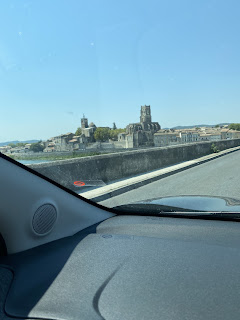




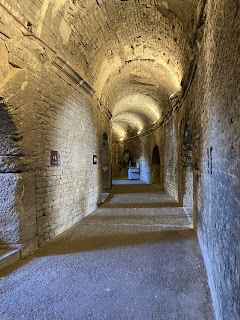





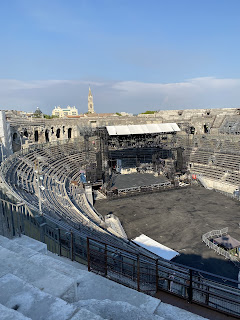


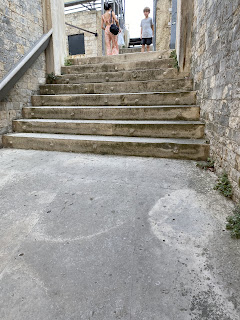















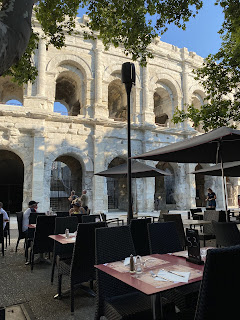


No comments:
Post a Comment